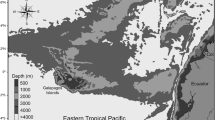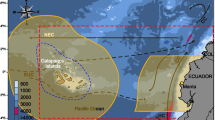Abstract
The ontogeny of pelagic species is difficult to study due to their migratory patterns and the inaccessibility of their habitats, leaving a large part of their life history little understood. The aim of this work is to investigate the trophic ontogeny of an individual of Isurus paucus based on isotopic analysis of long-term tissue (vertebra and muscle). Nine samples (taken from eight vertebral collagen and one muscle) were analysed, giving δ13C values between –17.8‰ and –14.6‰, indicating use of both coastal and oceanic zones. The δ13C and δ15N values suggest that this individual of I. paucus was a secondary-third level predator (trophic position: 3.5–5.7]), with a broad isotopic niche (SEAC = 3.97‰2). The isotopic values obtained suggest that I. paucus give birth in coastal waters and then migrate towards oceanic zones, while the level of isotopic enrichment could be an indicator of the food sources and trophic level of the mother.



Similar content being viewed by others
References
Bowman RE, Stillwell CE, Michaels WL, Grosslein MD (2000) Food of northwest Atlantic fishes and two common species of squid (NOAA Technical Memorandum NMFS-NE-155). Woods Hole, Massachusetts, USA
Bustamante C, Concha F, Balbontín F, Lamilla J (2009) Southernmost record of the Isurus paucus Gitart Manday, 1966 (Elasmobranchii: Lamnidae) in the southeast Pacific Ocean. Rev Biol Mar Oceanogr 44(2):523–526
Calle-Moran M (2010) Ecología trófica del tiburón zorro pelágico Alopias pelagicus en Santa Rosa de Salinas, Pacífico ecuatoriano. Dissertation, Universidad Nacional Autónoma de México
Castro JI (2011) The sharks of North America. Oxford University Press, New York
CITES (2013) Inclusión del tiburón mako de aleta corta, Isurus oxyrinchus y tiburón mako de aleta larga, Isurus paucus en el apendice II. Cop18 Prop. 42. Geneva, Switzerland
Compagno LJV (2002) Sharks of the world. An annotated and illustrated catalogue of shark species known to date. Bullhead, mackerel and carpet sharks. Vol. 2 (Heterodontiformes, Laminformes and Orectolobiformes). FAO, Species Catalogue for Fishery Purposes. No. 1 Vol. 2, FAO. Rome
Compagno LJV, Dando M, Fowler S (2005) Sharks of the world. Harper Collins Publisher, London
Dodrill JW, Gilmore RG (1979) First north American continental record of the longfin mako (Isurus paucus Guitart Manday). Fla Sci 42(1):52–58
Estrada JA, Rice AN, Lutcavage ME, Skomal GB (2003) Predicting trophic position in sharks of the north-west Atlantic Ocean using stable isotope analysis. J Mar Biol Assoc U K 83:1347–1350. https://doi.org/10.1017/S0025315403008798
Estrada JA, Rice AN, Natason LJ, Skomal GB (2006) Use of isotopic analysis of vertebrae in reconstructing ontogenetic feeding ecology in white sharks. Ecology 87(4):829–834
Estupiñán-Montaño C, Galván-Magaña F, Sánchez-González A, Elorriaga-Verplancken FR, Delgado-Antonio A, Páez-Rosas D (2019) Dietary ontogeny of the blue shark, Prionace glauca, based on the analysis of δ13C y δ15N in vertebrae. Mar Biol 166:101. https://doi.org/10.1007/s00227-019-3550-0
Estupiñán-Montaño C, Galván-Magaña F, Elorriaga-Verplancken F, Zetina-Rejón MJ, Sánchez-González A, Polo-Silva CJ, Villalobos-Ramírez DJ, Rojas-Cundumí J, Delgado-Huertas A (2021) Ontogenetic feeding ecology of the scalloped hammerhead shark Sphyrna lewini in the Colombian Eastern Tropical Pacific. Mar Ecol Prog Ser 663:127–143. https://doi.org/10.3354/meps13639
Ferreira LC, Thum M, Heithaus MR, Barnett A, Abrantes KG, Holmes BJ, Zamora LM, Frisch AJ, Pepperell JG, Burkholder D, Vaudo J, Nowicki R, Meeuwig J, Meekan MG (2017) The trophic role of a large marine predator, the tiger shark Galeocerdo cuvier. Sci Rep 7:7641. https://doi.org/10.1038/s41598-017-07751-2
Garrick J (1967) Revison of sharks of genus Isurus with description of a new species (Galeoidae, Lamnidae). Proc U W Natl Mus 118:663-690
Gilmore RG (1983) Observations on the embryos of the longfin mako, Isurus paucus, and the bigeye thresher, Alopias superciliosus. Copeia 1983:375–382
Hedges JI, Stern JH (1984) Carbon and nitrogen determinations of carbonate-containing solids. Limnol Oceanogr 29:657–663. https://doi.org/10.4319/lo.1984.29.3.0657
Hueter RE, Tynimski JP, Morris JJ, Abierno AR, Valdes JA (2017) Horizontal and vertical movements of longfin makos (Isurus paucus) tracked with satellite-linked tags in the northwestern Atlantic Ocean. Fish Bull 115(1):101–116. https://doi.org/10.7755/FB.115.1.9
Hussey NE, Wintner SP, Dudley SFJ, Cliff G, Cocks DT, MacNeil A (2010) Maternal investment and size-specific reproductive output in carcharhinid sharks. J Anim Ecol 79:184–193. https://doi.org/10.1111/j.1365-2656.2009.01623.x
Hussey NE, MacNeil MA, Siple MC, Popp BN, Dubley SFJ, Fisk AT (2015) Expanded trophic complexity among large sharks. Food Webs 4(2015):1–7. https://doi.org/10.1016/j.fooweb.2015.04.002
Jackson AL, Inger R, Parnell AC, Bearhop S (2011) Comparing isotopic niche widths among and within communities: SIBER – Stable Isotope Bayesian Ellipses in R. J Anim Ecol 80(3):595–602. https://doi.org/10.1111/j.1365-2656.2011.01806.x
Kim SL, Koch PL (2012) Methods to collect, preserve, and prepare elasmobranch tissues for stable isotope analysis. Environ Biol Fish 95(1):53–63. https://doi.org/10.1007/s10641-011-9860-9
Kim SL, Tinker MT, Estes JA, Koch PL (2012) Ontogenetic and among-individual variation in foraging strategies of northeast Pacific white sharks based on stable isotope analysis. PLoS ONE 7(9):e45068. https://doi.org/10.1371/journal.pone.0045068
Kiszka JJ, Charlot K, Hussey NE, Heithaus MR, Simon-Bouhet B, Humber F, Caurant F, Bustamante P (2014) Trophic ecology of common elasmobranchs exploited by artisanal shark fisheries off south-western Madagascar. Aquat Biol 23:29–38. https://doi.org/10.3354/ab00602
Logan HM, Lutcavage ME (2010) Stable isotope dynamics in elasmobranch fishes. Hydrobiologia 644(1):231–244
Lyons K, Preti A, Madigan DJ, Wells RJD, Blasius ME, Snodgrass OE, Kacev D, Harris JD, Dewar H, Kohin S, MacKenzie K, Lowe CG (2015) Insights into the life history and ecology of a large shortfin mako shark Isurus oxyrinchus captures in southern California. J Fish Biol 87:200–2011
MacNeil MA, Skomal GB, Fisk AT (2005) Stable isotopes form multiple tissues reveal diet switching in sharks. Mar Ecol Progr Ser 302:199–206. https://doi.org/10.3354/meps302199
Malpica-Cruz L, Herzka SZ, Sosa-Nishizaki O, Escobedo-Olvera MA (2013) Tissue-specific stable isotope ratio of shortfin mako (Isurus oxyrinchus) and white (Carcharodon carcharias) sharks as indicators of size-based differences in foraging habitat and trophic level. Fish Oceanogr 22(6):429–445. https://doi.org/10.1111/fog.12034
Mearns AJ, Olson RJ, Young DR, Schafer HA (1981) Trophic structure and the cesium-potassium ratio in the pelagic ecosystem. CCOFI Rep XXII: 99−110
Mucientes-Sandoval GR, Saborido-Rey (2008) Acercamiento a la composición de la dieta de Isurus oxyrinchus Rafinesque, 1981 (Elasmobranchii: Lamnidae) en aguas internacionales del Pacífico sur central. Rev Invest Mar 29(2):145–150
Páez-Rosas D, Aurioles-Gamboa D, Alava JJ, Palacios DM (2012) Stable isotopes indicate differing foraging strategies in two sympatric otariids of the Galapagos Islands. J Exp Mar Biol Ecol 424−425:44−52. https://doi.org/10.1016/j.jembe.2012.05.001
Polo-Silva C, Newsome SD, Galván-Magaña F, Grijalba-Bendeck M, Sanjuan-Muñoz A (2013) Trophic shift in the diet of the pelagic thresher shark based on stomach contents and stable isotope analyses. Mar Biol Res 9(10):958–971. https://doi.org/10.1080/17451000.2013.793802
Preti A, Soykan CU, Dewar H, wells RJD, Spear N, Kohin S, (2012) Comparative feeding ecology of shortfin mako, blue and thresher sharks in the California Current. Environ Biol Fish 95:127–146
Quezada-Romegialli C, Jackson AL, Harrod C (2018) tRophicPosition: Bayesian trophic position calculation with stable isotopes. R packages version 0.7.5. http://cran.r-project.org/web/packages/tRophicPsition
R Development Core Team (2017) R: A language and environment for statistical computing. R Foundation for Statistical Computing, Vienna, Austria. https://www.R-project.org/
Reardon MB, Gerber L, Cavanagh RD (2006) Isurus paucus. The IUCN Red List of Threatened Species 2006: e.T60225A12328101
Rigby CL, Barreto R, Carlson J, Fernando D, Fordham S, Francis MP, Jabado RW, Liu KM, Marshall A, Pacoureau N, Romanov E, Sherley RB, Winker H (2019) Isurus paucus. The IUCN Red List of Threatened Species, 2006, e.T60225A3095898. https://doi.org/10.2305/IUCN.UK.2019-1.RLTS.T60225A3095898.en
Tamburin E, Kim S, Elorriaga-Verplancken F, Madigan JD, Hoyos-Padilla M, Sánchez-González A, Hernández-Herrera A, Castillo-Géniz JL, Godinez-Padilla CJ, Galván-Magaña F (2019) Isotopic niche and resource sharing among young sharks (Carcharodon carcharias and Isurus oxyrinchus) in Baja California, Mexico. Mar Ecol Prog Ser 613:107–124. https://doi.org/10.3354/meps12884
Vaudo JJ, Matich P, Heithaus MR (2010) Mother-offspring isotope fractionation in two species of placentatrophic sharks. J Fish Biol 77:1724–1727. https://doi.org/10.1111/j.1095-8649.2010.02813.x
Acknowledgements
To the fishermen and fish merchants of Tarqui Beach (Manta, Ecuador). To the Instituto Andaluz de Ciencias de la Tierra, Granada, Spain and Alejandro Sandoval-Londoño. To Daniel Edgar for the translation of the manuscript, as well as to the anonymous reviewers for their assistance in improving the manuscript.
Funding
Fundación Alium Pacific and Instituto Andaluz de Ciencias de la Tierra (CSIC).
Author information
Authors and Affiliations
Contributions
Conceptualization: Colombo Estupiñán-Montaño; Methodology: Colombo Estupiñán-Montaño; Formal analysis and investigation: Colombo Estupiñán-Montaño; Writing – original draft preparation: Colombo Estupiñán-Montaño, Writing – review and editing: Antonio Delgado-Huertas.
Corresponding author
Ethics declarations
Conflict of Interest
The author(s) declared no conflicts of interest with respect to the research, authorship, and/or publication of this article.
Additional information
Publisher's Note
Springer Nature remains neutral with regard to jurisdictional claims in published maps and institutional affiliations.
Rights and permissions
About this article
Cite this article
Estupiñán-Montaño, C., Delgado-Huertas, A. Longfin Mako Shark, Isurus paucus, in the Eastern Tropical Pacific: First Evidence of Trophic Ontogeny Based on the Isotopic Analysis of Long-term Tissues. Thalassas 38, 49–55 (2022). https://doi.org/10.1007/s41208-022-00404-w
Received:
Revised:
Accepted:
Published:
Issue Date:
DOI: https://doi.org/10.1007/s41208-022-00404-w




